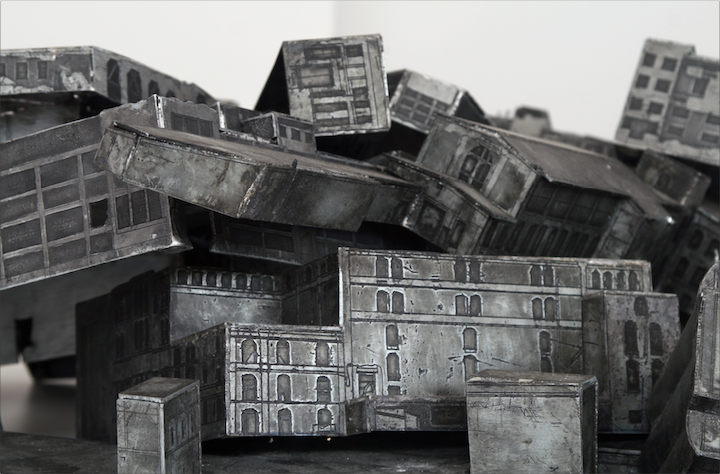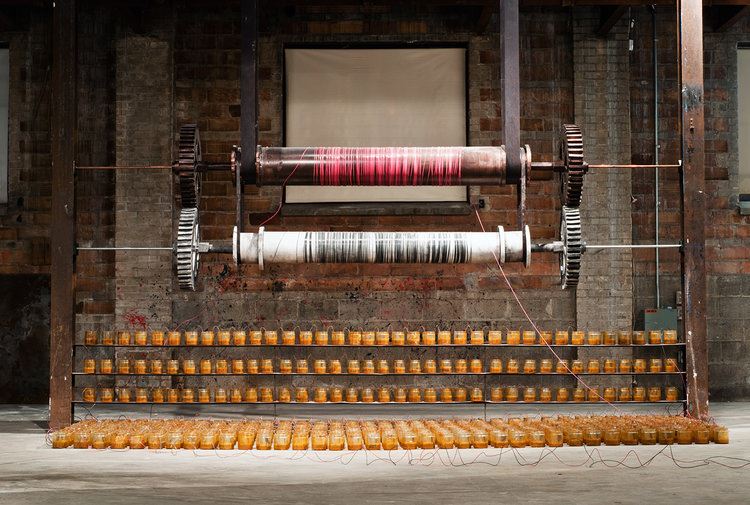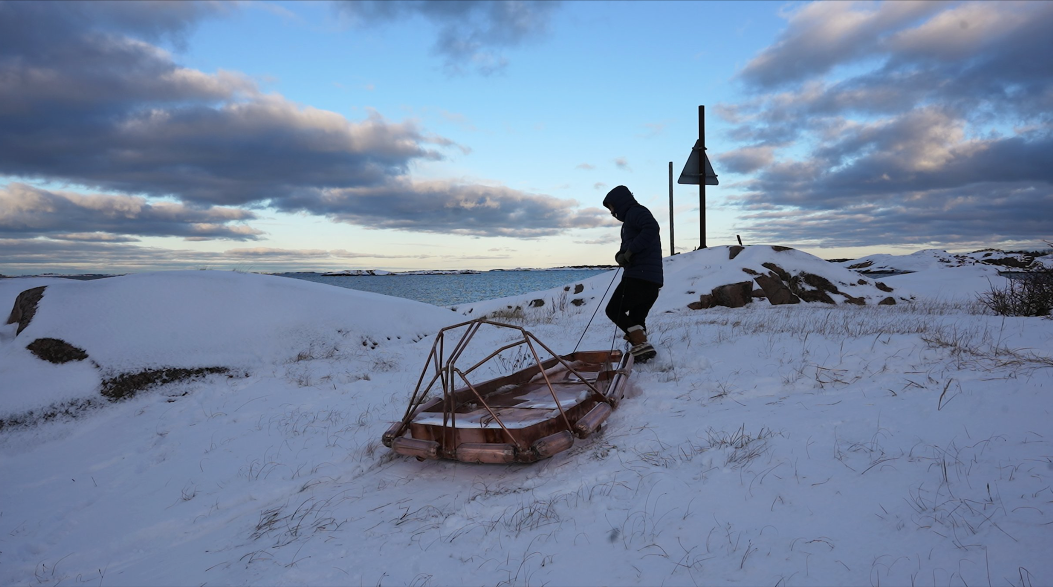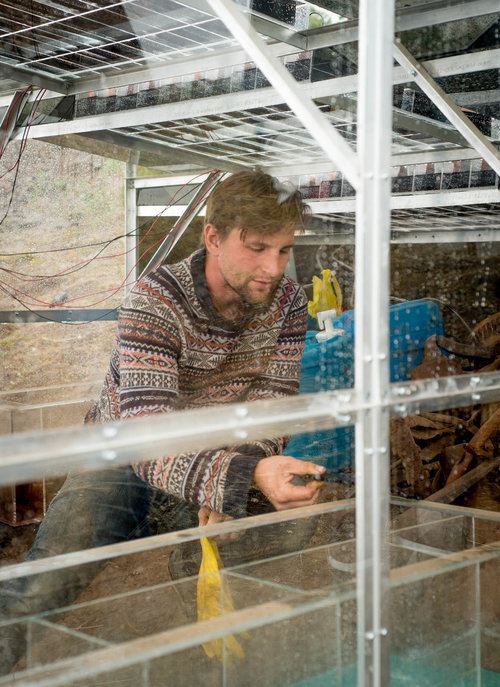
MEMBER SPOTLIGHT
July 17, 2023
This week we recognize Colin LyonsColin Lyons, and his fifteen year practice focused on geoengineering, extraction, alchemy, historical preservation and brownfield rehabilitation.
"Boom Town," 2007-2009 (above) is modeled after former industrial buildings along Montreal’s Lachine Canal, and is an installation of print-based sculptures that considers the possibilities after industrial obsolescence. Meticulously rendered from source photographs, these etching plates are first printed as blueprints, and later cut and folded to make small-scale paper architectures. Finally, the end of the edition is marked by soldering the plates together, thwarting the process of mass production, while giving the plates a new purpose. Piled on top of one another, these sculptures can be read as a mass burial site, monument, or heap of scrap metal. The incongruity of these industrial structures built delicately out of paper reminds us of the one-time assumption of invincibility within these industries."
click images for more info

"The Conservator, 2013 (above) is a site-specific sculpture designed for The Soap Factory. This restoration machine was powered by a sprawling battery, where hundreds of cells were created from discarded zinc and copper etching plates, and fueled by a ferric chloride etching solution. Designed to polish a rusted I-beam within the gallery space, this process revealed a small space of gentrification within this post-industrial ruin. Through the process, the battery simultaneously erodes the plates, allowing it to hold a charge for just a few minutes. In the reclaiming of industrial complexes, the impulse to polish the architecture has become almost habitual, cleansing the space of its industrial heritage, and marking its new existence. This installation reverses that practice, where the act of polishing brings a sharpened awareness of the labour that was once performed within the space."

"During Lyons first visit to Dawson City, in January 2010, he was brought to look out at the vast intestinal tailing piles left by decades of dredging in the area. This vista became the lasting image of his trip to the Yukon. In revisiting Dawson, Lyon began with a quintessentially Klondike activity – a kind of treasure hunting. Over the course of several weeks, he walked along the dredge tailings near Bonanza Creek, using a metal detector to excavate industrial cast-offs. With this collection in tow, he brought it to the Midnight Dome, where he installed my "Time Machine for abandoned futures" 2015 (above); a strange off-the-grid laboratory which became my home for over a week. This shelter adopts design strategies common in earthship architecture (rain-water collection, south facing greenhouse windows, rammed earth, etc.), but rather than environmental sustainability as its guiding principle, this bubbling chemical structure comes closer to the absurd inefficiency of many of our modern industrial pursuits. Powering this machine is a massive, roof-top battery, in which etching plates and etching acid power an electrolytic cleaning process to remove the rust from my scavenged artifacts. Once cleaned, Lyon meticulously etches the markings left by decades of rust and erosion, forming a kind of topographical map. The result is a glistening surface that memorializes the artifact’s entire lifespan. Overlooking the dredge tailings, this machine presents a kind of prototype for the preservation of degradation."

"We will find salvation in strategic chemical spills," 2022 (above) considers recent climate-engineering proposals through the lens of alchemy. The prints borrow cloudscapes from 16th Century engraver/alchemist Hendrick Goltzius’ Metamorphoses, which depict atmosphere as solid and material, rather than a non-space; a vital concept in an age of rapidly rising atmospheric carbon levels. But here, the gods are replaced by geoengineering schemes - proposals to wash away the sins of the Anthropocene. Silkscreened over these etchings are materials such as crude oil, sulfuric acid, iron sulfate, olivine, sea salt, silica, and pyrite, which might play a role in future geoengineering technologies. Over the coming years, these images depicting congressional documents and volcanic eruptions will become increasingly visible, as the urgency to deploy these radical climate “solutions” intensifies. Etched into their plexiglass frames, and casting shadows onto the wall are descriptive technical texts written in Esperanto, pointing to the need for a new global governance structure for the coming era of global climate modification, when the key question might center on who has the right to experiment with the environment, when the burden of responsibility and the burden of impact are asymmetrical."
In 1942, British inventor Geoffrey Pyke proposed an ambitious plan to develop a massive, ice-based aircraft carrier code-named Operation Habbakuk (aka ‘Bergship’). Soon after, a team of Canadian conscientious objectors were sent to Jasper National Park to develop a 1000-ton prototype that would utilize a new material called Pykrete - a mixture of wood pulp and ice, which was believed to be easily repairable and nearly unsinkable. However, the project was eventually abandoned, and its remains now rest at the bottom of Patricia Lake. "At its core "Operation Habbakuk," 2022 (below) explores the science of geo-engineering attempts to mimic, accelerate, or amplify natural processes of carbon reduction using highly invasive means. These strategies form a dystopian contingency plan which, employed alongside mitigation efforts, strive to preserve a close approximation of our present ecosystem. Geo-engineering stands as a kind of messianic figure for the planet, proposing to wash away the sins of the Anthropocene. However, instead of practical geoengineering prototypes, Lyons techno-solutions offer little more than time capsules, laying bare the folly of our desire to find salvation in the fine balance of strategic chemical spills, and proposing rituals which blend the sacred and scientific to question what kind of nature we hope to approximate within a techno-solutionist future."

Colin Lyons grew up in the birthplace of the North American oil industry, Petrolia, Ontario in Canada, an experience that has fueled his interests in industrial ruins and sacrificial landscapes. His most recent site-based installations have been located in mine tailing piles, decommissioned landfills, historic flood infrastructure, urban brownfields, and remote islands. In recent years, Lyons has participated in fellowships and residencies including MacDowell in New Hampshire, The Arctic Circle Residency in Svalbard, and ÖRES on the island in Finland. His work has been shown widely in recent solo and group exhibitions internationally, and his projects have been supported by the Canada Council for the Arts, New York Foundation for the Arts, Conseil des Arts et des Lettres du Quebec, Alberta Foundation for the Arts, The Santo Foundation, The Elizabeth Greenshields Foundation, and The National Trust for Historic Preservation. He received his BFA from Mount Allison University (2007) and MFA in printmaking from University of Alberta (2012). Lyons currently lives in Binghamton, New York, where he is an assistant professor at Binghamton University (SUNY). www.colinlyons.ca
Featured images (top to bottom): ©Colin Lyons, Boom Town 2007-2009, etching on paper, wood, zinc etching plates; The Conservator, 2022, (battery: zinc plates, copper plates, glass, wire, ferric chloride), photo by Sarah Nienaber; Time Machine for Abandoned Futures, 2015, Plexiglas, aluminum, copper sulfate, soda ash, copper plates, zinc plates, wires, artifacts; We will find salvation in strategic chemical spills, 2022, iron Fertilization, etching, silkscreen (printed with iron sulfate, ferric chloride, olivine and rust from gold-rush artifacts), laser engraving, 22 x 15 inches; Operation Habbakuk, 2022, video still from Operation Habbakuk (2:45), produced at MacDowell and ÖRES through the generous support of the Canada Council for the Arts; Portrait of artist by Evan Rensch.
